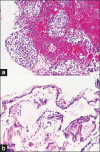Symptomatic Rathke's cleft cyst with a co-existing pituitary tumor; Brief review of the literature
- PMID: 24551002
- PMCID: PMC3912769
- DOI: 10.4103/1793-5482.125662
Symptomatic Rathke's cleft cyst with a co-existing pituitary tumor; Brief review of the literature
Abstract
Pituitary adenomas and Rathke's cleft cysts (RCCs) share a common embryological origin. Occasionally, these two lesions can present within the same patient. We present a case of a 39-year-old male who was found to have a large sellar lesion after complaints of persistent headaches and horizontal nystagmus. Surgical resection revealed components of a RCC co-existing with a pituitary adenoma. A brief review of the literature was performed revealing 38 cases of co-existing Rathke's cleft cysts and pituitary adenomas. Among the cases, the most common symptoms included headache and visual changes. Rathke's cleft cysts and pituitary adenomas are rarely found to co-exist, despite having common embryological origins. We review the existing literature, discuss the common embryology to these two lesions and describe a unique case from our institution of a co-existing Rathke's cleft cyst and pituitary adenoma.
Keywords: Adenoma; Rathke's cleft cyst; development; neoplasm; pituitary; sella; tumor.
Conflict of interest statement
Figures


Similar articles
-
Rathke's cleft cysts: differentiation from other cystic lesions in the pituitary fossa by use of single-shot fast spin-echo diffusion-weighted MR imaging.Acta Neurochir (Wien). 2007 Aug;149(8):759-69; discussion 769. doi: 10.1007/s00701-007-1234-x. Epub 2007 Jul 9. Acta Neurochir (Wien). 2007. PMID: 17594050
-
Pituitary adenoma and concomitant Rathke's cleft cyst.Acta Neurochir (Wien). 2007 Dec;149(12):1223-8. doi: 10.1007/s00701-007-1295-x. Epub 2007 Oct 3. Acta Neurochir (Wien). 2007. PMID: 17914599 Review.
-
[A case of non-functional pituitary adenoma associated with Rathke's cleft cyst].No Shinkei Geka. 2005 Aug;33(8):797-803. No Shinkei Geka. 2005. PMID: 16095210 Review. Japanese.
-
Rathke's cleft cyst marsupialization and repair with a free mucosal graft - Video case report and literature review.Am J Otolaryngol. 2022 Sep-Oct;43(5):103519. doi: 10.1016/j.amjoto.2022.103519. Epub 2022 Jun 4. Am J Otolaryngol. 2022. PMID: 35690516 Review.
-
Concomitant pituitary adenoma and Rathke's cleft cyst.Neuroradiology. 2001 Sep;43(9):755-9. doi: 10.1007/s002340100559. Neuroradiology. 2001. PMID: 11594426
Cited by
-
Spontaneous regression of paediatric pituitary lesions-report of 2 cases and literature review.Childs Nerv Syst. 2024 Nov 27;41(1):6. doi: 10.1007/s00381-024-06680-6. Childs Nerv Syst. 2024. PMID: 39601895 Review.
-
Concurrent growth hormone-producing pituitary adenoma and Rathke's cleft cyst.BMJ Case Rep. 2022 Aug 19;15(8):e250332. doi: 10.1136/bcr-2022-250332. BMJ Case Rep. 2022. PMID: 35985746 Free PMC article.
-
Collision sellar lesions: coexistence of pituitary adenoma and Rathke cleft cyst-a single-center experience.Endocrine. 2020 Apr;68(1):174-181. doi: 10.1007/s12020-019-02149-8. Epub 2019 Dec 4. Endocrine. 2020. PMID: 31802354
-
Cushing's Syndrome in a Patient With Rathke's Cleft Cyst and ACTH Cell Hyperplasia Detected by 11C-Methionine PET Imaging-A Case Presentation.Front Endocrinol (Lausanne). 2020 Jul 22;11:460. doi: 10.3389/fendo.2020.00460. eCollection 2020. Front Endocrinol (Lausanne). 2020. PMID: 32774326 Free PMC article.
-
GH-Producing Pituitary Adenoma and Concomitant Rathke's Cleft Cyst: A Case Report and Short Review.Case Rep Neurol Med. 2015;2015:948025. doi: 10.1155/2015/948025. Epub 2015 Mar 25. Case Rep Neurol Med. 2015. PMID: 25883817 Free PMC article.
References
-
- Nishio S, Mizuno J, Barrow DL, Takei Y, Tindall GT. Pituitary tumors composed of adenohypophysial adenoma and Rathke's cleft cyst elements: A clinicopathological study. Neurosurgery. 1987;21:371–7. - PubMed
-
- Shanklin WM. The histogenesis and histology of an integumentary type of epithelium in the human hypophysis. Anat Rec. 1951;109:217–31. - PubMed
-
- Naylor MF, Scheithauer BW, Forbes GS, Tomlinson FH, Young WF. Rathke cleft cyst; CT, MR, and pathology of 23 cases. J Comput Assist Tomogr. 1995;19:853–9. - PubMed
-
- Itoh J, Usui K. An entirely suprasellar symptomatic Rathke's cleft cyst: Case report. Neurosurgery. 1992;30:581–5. - PubMed
-
- Oka H, Kawano N, Suwa T, Yada K, Kan S, Kameya T. Radiological study of symptomatic Rathke's cleft cysts. Neurosurgery. 1994;35:632–6. - PubMed
Publication types
LinkOut - more resources
Full Text Sources
Other Literature Sources

